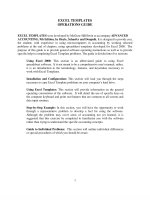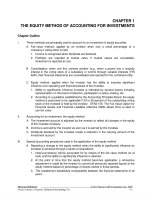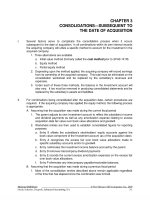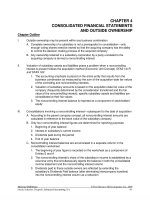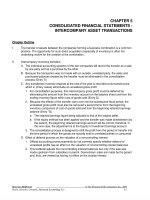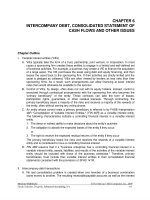Solution manual advanced accounting 9e by hoyle ch02
Bạn đang xem bản rút gọn của tài liệu. Xem và tải ngay bản đầy đủ của tài liệu tại đây (551.61 KB, 32 trang )
Find more slides, ebooks, solution manual and testbank on www.downloadslide.com
CHAPTER 2
CONSOLIDATION OF FINANCIAL INFORMATION
Major changes have occurred for financial reporting for business combinations. These changes
are documented in SFAS No. 141R, “Business Combinations” and SFAS No. 160,
“Noncontrolling Interests and Consolidated Financial Statements” (to replace Accounting
Research Bulletin 51). These new pronouncements require the acquisition method instead of
the purchase method. The acquisition method emphasizes fair values for recording all
combinations as opposed to the cost-based provisions of SFAS 141.
In this chapter, we first provide coverage of expansion through corporate takeovers and an
overview of the consolidation process. Then we present the acquisition method of accounting
for business combinations followed by limited coverage of the purchase method and pooling of
interests provided in a separate sections.
Chapter Outline
I.
Business combinations and the consolidation process
A. A business combination is the formation of a single economic entity, an event that
occurs whenever one company gains control over another
B. Business combinations can be created in several different ways
1. Statutory merger—only one of the original companies remains in business as a
legally incorporated enterprise.
a. Assets and liabilities can be acquired with the seller then dissolving itself as a
corporation.
b. All of the capital stock of a company can be acquired with the assets and
liabilities then transferred to the buyer followed by the seller’s dissolution.
2. Statutory consolidation—assets or capital stock of two or more companies are
transferred to a newly formed corporation
3. Acquisition by one company of a controlling interest in the voting stock of a
second. Dissolution does not take place; both parties retain their separate legal
incorporation.
C. Financial information from the members of a business combination must be
consolidated into a single set of financial statements representing the entire
economic entity.
1. If the acquired company is legally dissolved, a permanent consolidation is
produced on the date of acquisition by entering all account balances into the
financial records of the surviving company.
2. If separate incorporation is maintained, consolidation is periodically simulated
whenever financial statements are to be prepared. This process is carried out
through the use of worksheets and consolidation entries.
McGraw-Hill/Irwin
Hoyle, Schaefer, Doupnik, Advanced Accounting, 9/e
© The McGraw-Hill Companies, Inc., 2009
2-1
Find more slides, ebooks, solution manual and testbank on www.downloadslide.com
II.
The Acquisition Method
A. The acquisition method has been adopted by the FASB in SFAS 141R to replace the
purchase method.
For combinations resulting in complete ownership, it is
distinguished by four characteristics.
1. All assets acquired and liabilities assumed in the combination are recognized and
measured at their individual fair values (with few exceptions).
2. The fair value of the consideration transferred provides a starting point for valuing
and recording a business combination.
a. The consideration transferred includes cash, securities, and contingent
performance obligations.
b. Direct combination costs are not considered as part of the fair value of the
consideration transferred for the acquired firm and are expensed as incurred.
c. Stock issuance costs are recorded as a reduction in paid-in capital and are
not considered to be a component of the consideration transferred.
d. The fair value of any noncontrolling interest also adds to the valuation of the
acquired firm and is covered beginning in Chapter 4 of the text.
3. Any excess of the fair value of the consideration transferred over the net amount
assigned to the individual assets acquired and liabilities assumed is recognized
by the acquirer as goodwill.
4. Any excess of the net amount assigned to the individual assets acquired and
liabilities assumed over the fair value of the consideration transferred is
recognized by the acquirer as a “gain on bargain purchase.”
B. SFAS 141R requires that in-process research and development acquired in a
business combination be recognized as an asset at its acquisition-date fair value.
III.
The Purchase Method
A. The purchase method was applicable for business combinations occurring for fiscal
years beginning prior to December 15, 2008. It was distinguished by three
characteristics.
1. One company was clearly in a dominant role as the purchasing party
2. A bargained exchange transaction took place to obtain control over the second
company
3. An historical cost figure was determined based on the acquisition price paid
a. The cost of the acquisition included any direct combination costs.
b. Stock issuance costs were recorded as a reduction in paid-in capital and are
not considered to be a component of the acquisition price.
B. Purchase method procedures where dissolution of the acquired company took place
1. The assets and liabilities being obtained were recorded by the buyer at fair value
as of the date of acquisition
2. Any portion of the payment made in excess of the fair value of these assets and
liabilities was attributed to an intangible asset commonly referred to as goodwill.
3. If the price paid was below the fair value of the assets and liabilities, the accounts
of the acquired company were still recorded at fair value except that the values of
certain noncurrent assets were reduced in total by the excess cost. If these
McGraw-Hill/Irwin
2-2
© The McGraw-Hill Companies, Inc., 2009
Solutions Manual
Find more slides, ebooks, solution manual and testbank on www.downloadslide.com
values were not great enough to absorb the entire reduction, an extraordinary
gain was recognized.
C. Purchase method where separate incorporation of all parties was maintained.
1. Consolidation figures were the same as when dissolution took place.
2. A worksheet was normally utilized to simulate the consolidation process so that
financial statements can be produced periodically.
IV.
The Pooling of Interest Method (SFAS 141 prohibits new poolings after June 30, 2001)
A. A pooling of interests is formed by the uniting of the ownership interests of two
companies through the exchange of equity securities. The characteristics of a
pooling are fundamentally different from either the purchase or acquisition methods.
1. Neither party was truly viewed as an acquiring company.
2. Precise cost figures stemming from the exchange of securities were difficult to
ascertain.
3. The transaction affected the stockholders rather than the companies.
Prior to SFAS 141 business combinations meeting twelve criteria established by
the Accounting Principles Board (in its Opinion 16) were accounted for as a
pooling of interests. If even one of the twelve was not satisfied, the combination
was automatically viewed as a purchase.
B. Pooling of interests where dissolution occurred
1. Because of the nature of a pooling, determination of an acquisition price was not
relevant
a. Since no acquisition price was computed, all direct costs of creating the
combination were expensed immediately.
b. In addition, new goodwill arising from the combination was never recognized
in a pooling of interests. Similarly, no valuation adjustments were recorded for
any of the assets or liabilities combined.
2. The book values of the two companies were simply brought together to produce
a set of consolidated financial records. A pooling was viewed as affecting the
owners rather than the two companies.
3. The results of operations reported by both parties were combined on a
retroactive basis as if the companies had always been together.
4. Controversy historically surrounded the pooling of interests method
a. Any cost figures indicated by the exchange transaction that created the
combination were ignored.
b. Income balances previously reported were altered since operations were
combined on a retroactive basis.
c. Reported net income was usually higher in subsequent years than in a
purchase since no goodwill or valuation adjustments were recognized which
require amortization.
C. A pooling of interests where separate incorporation is maintained also combined the
book values of the companies for periodic reporting purposes but the process is
carried out on a worksheet.
McGraw-Hill/Irwin
Hoyle, Schaefer, Doupnik, Advanced Accounting, 9/e
© The McGraw-Hill Companies, Inc., 2009
2-3
Find more slides, ebooks, solution manual and testbank on www.downloadslide.com
Learning Objectives
Having completed Chapter Two, “Consolidation of Financial Information,” students should be
able to fulfill each of the following learning objectives.
1.
Understand that a single economic entity is formed by the uniting of two or more
companies under the control of one party.
2.
Understand the term “business combination.”
3.
Differentiate between a statutory merger, a statutory consolidation, and a business
combination formed when one company acquires control over another and both remain
incorporated.
4.
Realize that, if dissolution does not take place, the consolidation process must be
repeated at periodic intervals whenever financial statements are produced for the single
entity.
5.
Understand the valuation principles of the acquisition method.
6.
Determine the total fair value of the consideration transferred for an acquisition and
allocate that fair value to specific subsidiary accounts (including in-process research and
development assets), goodwill, or a gain on bargain purchase.
7.
Prepare the journal entry to consolidate the accounts of a subsidiary if dissolution takes
place.
8.
Using the acquisition method, prepare a worksheet to consolidate the accounts of two
companies that form a business combination if dissolution is not to take place.
9.
Know the two criteria for recognizing intangible assets apart from goodwill acquired in a
business combination.
10.
Account for the direct costs incurred in forming a business combination.
11.
Identify the general characteristics of the purchase method and the general
characteristics of a pooling of interests.
12.
Understand that although the pooling method and purchase methods are no longer
applicable for new business combinations, that the prohibition is not retroactive. Thus the
financial reporting effects of poolings will be with us for decades to come.
13.
Understand the theoretical problems often associated with a pooling of interests.
McGraw-Hill/Irwin
2-4
© The McGraw-Hill Companies, Inc., 2009
Solutions Manual
Find more slides, ebooks, solution manual and testbank on www.downloadslide.com
Answers to Questions
1.
2.
3.
4.
5.
6.
A business combination is the process of forming a single economic entity by the uniting
of two or more organizations under common ownership. The term also refers to the
entity that results from this process.
(1) A statutory merger is created whenever two or more companies come together to
form a business combination and only one remains in existence as an identifiable entity.
This arrangement is often instituted by the acquisition of substantially all of an
enterprise’s assets. (2) a statutory merger can also be produced by the acquisition of a
company’s capital stock. This transaction is labeled a statutory merger if the acquired
company transfers its assets and liabilities to the buyer and then legally dissolves as a
corporation. (3) A statutory consolidation results when two or more companies transfer
all of their assets or capital stock to a newly formed corporation. The original companies
are being “consolidated” into the new entity. (4) A business combination is also formed
whenever one company gains control over another through the acquisition of
outstanding voting stock. Both companies retain their separate legal identities although
the common ownership indicates that only a single economic entity exists.
Consolidated financial statements represent accounting information gathered from two
or more separate companies. This data, although accumulated individually by the
organizations, is brought together (or consolidated) to describe the single economic
entity created by the business combination.
Companies that form a business combination will often retain their separate legal
identities as well as their individual accounting systems. In such cases, internal financial
data continues to be accumulated by each organization. Separate financial reports may
be required for outside shareholders (a noncontrolling interest), the government, debt
holders, etc. This information may also be utilized in corporate evaluations and other
decision making. However, the business combination must periodically produce
consolidated financial statements encompassing all of the companies within the single
economic entity. A worksheet is used to organize and structure this process. The
worksheet allows for a simulated consolidation to be carried out on a regular, periodic
basis without affecting the financial records of the various component companies.
Several situations can occur in which the fair value of the 50,000 shares being issued
might be difficult to ascertain. These examples include:
The shares may be newly issued (if Jones has just been created) so that no
accurate value has yet been established;
Jones may be a closely held corporation so that no fair value is available for its
shares;
The number of newly issued shares (especially if the amount is large in comparison
to the quantity of previously outstanding shares) may cause the price of the stock to
fluctuate widely so that no accurate fair value can be determined during a
reasonable period of time;
Jones’ stock may have historically experienced drastic swings in price. Thus, a
quoted figure at any specific point in time may not be an adequate or representative
value for long-term accounting purposes.
For combinations resulting in complete ownership, the acquisition method allocates the
fair value of the consideration transferred to the separately recognized assets acquired
and liabilities assumed based on their individual fair values.
McGraw-Hill/Irwin
Hoyle, Schaefer, Doupnik, Advanced Accounting, 9/e
© The McGraw-Hill Companies, Inc., 2009
2-5
Find more slides, ebooks, solution manual and testbank on www.downloadslide.com
7.
8.
9.
10.
11.
The revenues and expenses (both current and past) of the parent are included within
reported figures. However, the revenues and expenses of the subsidiary are only
consolidated from the date of the acquisition forward. The operations of the subsidiary
are only applicable to the business combination if earned subsequent to its creation.
Morgan’s additional purchase price may be attributed to many factors: expected
synergies between Morgan’s and Jennings’ assets, favorable earnings projections,
competitive bidding to acquire Jennings, etc. In general however, under the acquisition
method, any amount paid by the parent company in excess of the fair values of the
subsidiary’s net assets is reported as goodwill.
All of the subsidiary’s asset and liability accounts are usually recorded at fair value (see
Answer 6 above). Under the acquisition method, in the vast majority of cases the assets
acquired and liabilities assumed in a business combination are recorded at their fair
values. If the fair value of the consideration transferred (including any contingent
consideration) is less than the total net fair value assigned to the assets acquired and
liabilities assumed, then an ordinary gain is recognized for the difference.
Shares issued are recorded at fair value as if the stock had been sold and the money
obtained used to acquire the subsidiary. The Common Stock account is recorded at the
par value of these shares with any excess amount attributed to additional paid-in capital.
Under the acquisition method, direct combination costs are not considered part of the
fair value of the consideration transferred and thus are not included in the purchase
price. These direct combination costs are allocated to expense in the period in which
they occur. Stock issue costs are treated under the acquisition method in the same way
as under the purchase method, i.e., as a reduction of APIC.
McGraw-Hill/Irwin
2-6
© The McGraw-Hill Companies, Inc., 2009
Solutions Manual
Find more slides, ebooks, solution manual and testbank on www.downloadslide.com
Answers to Acquisition Method Problems
1.
B
2.
D
3.
C
4.
A
5.
D
6.
D
7.
B
Consideration transferred (fair value)
Fair value of identifiable assets
$800,000
Cash
A/R
Software
In-process R&D
Liabilities
Fair value of net identifiable assets acquired
Goodwill
8.
$150,000
140,000
320,000
200,000
(130,000)
680,000
$120,000
C Atkins records new shares at fair value
Value of shares issued (51,000 × $3) ...................................... $153,000
Par value of shares issued (51,000 × $1) ................................
51,000
Additional paid-in capital (new shares) ................................. $102,000
Additional paid-in capital (existing shares) ..........................
90,000
Consolidated additional paid-in capital ................................. $192,000
At the date of acquisition, the parent makes no change to retained
earnings.
9.
B Consideration transferred (fair value) .........................
Book value of subsidiary (assets minus liabilities) ....
Fair value in excess of book value ..........................
Allocation of excess fair over book value
identified with specific accounts:
Inventory....................................................................
Patented technology .................................................
Buildings and equipment .........................................
Long-term liabilities ..................................................
Goodwill ....................................................................
McGraw-Hill/Irwin
Hoyle, Schaefer, Doupnik, Advanced Accounting, 9/e
$400,000
(300,000)
100,000
30,000
20,000
25,000
10,000
$15,000
© The McGraw-Hill Companies, Inc., 2009
2-7
Find more slides, ebooks, solution manual and testbank on www.downloadslide.com
10. A Only the subsidiary’s post-acquisition income is included in consolidated
totals.
11. a. From SFAS 141R an intangible asset acquired in a business combination
shall be recognized as an asset apart from goodwill if it arises from
contractual or other legal rights (regardless of whether those contractual
or legal rights are transferable or separable from the acquired enterprise
or from other rights and obligations). If an intangible asset does not arise
from contractual or other legal rights, it shall be recognized as an asset
apart from goodwill only if it is separable, that is, it is capable of being
separated or divided from the acquired enterprise and sold, transferred,
licensed, rented, or exchanged (regardless of whether there is an intent to
do so). An intangible asset that cannot be sold, transferred, licensed,
rented, or exchanged individually is considered separable if it can be sold,
transferred, licensed, rented, or exchanged with a related contract, asset,
or liability.
b.
Trademarks—usually meet both the separability and legal/contractual
criteria.
A customer list—usually meets the separability criterion.
Copyrights on artistic materials—usually meet both the separability
and legal/contractual criteria.
Agreements to receive royalties on leased intellectual property—
usually meet the legal/contractual criterion.
Unpatented technology—may meet the separability criterion if capable
of being sold even if in conjunction with a related contract, asset, or
liability.
McGraw-Hill/Irwin
2-8
© The McGraw-Hill Companies, Inc., 2009
Solutions Manual
Find more slides, ebooks, solution manual and testbank on www.downloadslide.com
12. (15 Minutes) (Consolidated balances)
In acquisitions, the fair values of the subsidiary's assets and liabilities are
consolidated (there are a limited number of exceptions). Goodwill is reported
as $80,000, the amount that the $760,000 consideration transferred exceeds
the $680,000 fair value of Sun’s net assets acquired.
Inventory = $670,000 (Parrot's book value plus Sun's fair value)
Land = $710,000 (Parrot's book value plus Sun's fair value)
Buildings and equipment = $930,000 (Parrot's book value plus Sun's
fair value)
Franchise agreements = $440,000 Parrot's book value plus Sun's fair
value)
Goodwill = $80,000 (calculated above)
Revenues = $960,000 (only parent company operational figures are
reported at date of acquisition)
Additional Paid-in Capital = $65,000 (Parrot's book value less stock
issue costs)
Expenses = $940,000 (only parent company operational figures plus
acquisition-related costs are reported at date of acquisition)
Retained Earnings, 1/1 = $390,000 (Parrot's book value)
13. (20 Minutes) (Determine selected consolidated balances)
Under the acquisition method, the shares issued by Wisconsin are recorded
at fair value:
Investment in Badger (value of debt and shares issued)
Common Stock (par value) ...........................................
Additional Paid-in Capital (excess over par value) .....
Liabilities .......................................................................
900,000
150,000
450,000
300,000
The payment to the broker is accounted for as an expense. The stock issue
cost is a reduction in additional paid-in capital.
Professional services expense .........................................
Additional Paid-in Capital ..................................................
Cash .............................................................................
30,000
40,000
70,000
Allocation of Acquisition-Date Excess Fair Value:
Consideration transferred (fair value) for Badger Stock
Book Value of Badger, 6/30 ...............................................
Fair Value in Excess of Book Value .............................
McGraw-Hill/Irwin
Hoyle, Schaefer, Doupnik, Advanced Accounting, 9/e
$900,000
770,000
$130,000
© The McGraw-Hill Companies, Inc., 2009
2-9
Find more slides, ebooks, solution manual and testbank on www.downloadslide.com
13. (continued)
Excess fair value (undervalued equipment) .....................
Excess fair value (overvalued patented technology) .......
Goodwill ........................................................................
CONSOLIDATED BALANCES:
Net income (adjusted for combination expenses. The
figures earned by the subsidiary prior to the takeover
are not included) ......................................................................
Retained Earnings, 1/1 (the figures earned by the subsidiary
prior to the takeover are not included) ...................................
Patented Technology (the parent's book value plus the fair
value of the subsidiary) ...........................................................
Goodwill (computed above) ....................................................
Liabilities (the parent's book value plus the fair value
of the subsidiary's debt plus the debt issued by the parent
in acquiring the subsidiary) ....................................................
Common Stock (the parent's book value after recording
the newly-issued shares) ........................................................
Additional Paid-in Capital (the parent's book value
after recording the two entries above) ...................................
100,000
(20,000)
$50,000
$ 210,000
800,000
1,180,000
50,000
1,210,000
510,000
680,000
14. (50 Minutes) (Determine consolidated balances for a bargain purchase.)
Prove those figures with a worksheet)
a. Marshall’s acquisition of Tucker represents a bargain purchase because
the fair value of the net assets acquired exceeds the fair value of the
consideration transferred as follows:
Fair value of consideration transferred
$400,000
Fair value of net assets acquired
515,000
Gain on bargain purchase
$115,000
In a bargain purchase, the acquisition is recorded at the fair value of the
net assets acquired instead of the fair value of the consideration
transferred (an exception to the general rule).
Prior to preparing a consolidation worksheet, Marshall records the three
transactions that occurred to create the business combination.
Investment in Tucker ....................................
515,000
Long-Term Liabilities ..............................
200,000
Common Stock (par value) .....................
20,000
Additional Paid-in Capital .......................
180,000
Gain on Bargain Purchase ......................
115,000
McGraw-Hill/Irwin
2-10
© The McGraw-Hill Companies, Inc., 2009
Solutions Manual
Find more slides, ebooks, solution manual and testbank on www.downloadslide.com
(To record liabilities and stock issued for Tucker acquisition fair value)
14. (continued)
Combination expenses .................................
Cash..........................................................
30,000
(to record payment of combination fees)
30,000
Additional Paid-in Capital.............................
12,000
Cash..........................................................
12,000
(To record payment of stock issuance costs)
Marshall's trial balance is adjusted for these transactions (as shown in the
worksheet that follows).
Next, the fair of the $400,000 investment is allocated:
Consideration transferred at fair value..............................
Book value (assets minus liabilities or
total stockholders' equity) ............................................
Book value in excess of consideration transferred .........
Allocation to specific accounts based on fair value:
Inventory ........................................................................
Land ................................................................................
Buildings ........................................................................
Gain on bargain purchase (excess net asset fair value
over consideration transferred) ....................................
CONSOLIDATED TOTALS
$400,000
460,000
(60,000)
5,000
20,000
30,000
$(115,000)
Cash = $38,000. Add the two book values less acquisition costs
Receivables = $360,000. Add the two book values.
Inventory = $505,000. Add the two book values plus the fair value
adjustment
Land = $400,000. Add the two book values plus the fair value adjustment.
Buildings = $670,000. Add the two book values plus the fair value
adjustment.
Equipment = $210,000. Add the two book values.
Total assets = $2,183,000. Summation of the above individual figures.
Accounts payable = $190,000. Add the two book values.
Long-term liabilities = $830,000. Add the two book values plus the debt
incurred by the parent in acquiring the subsidiary.
Common stock = $130,000.The parent's book value after stock issue to
acquire the subsidiary.
Additional paid-in capital = $528,000.The parent's book value after the
stock issue to acquire the subsidiary less the stock issue costs.
McGraw-Hill/Irwin
Hoyle, Schaefer, Doupnik, Advanced Accounting, 9/e
© The McGraw-Hill Companies, Inc., 2009
2-11
Find more slides, ebooks, solution manual and testbank on www.downloadslide.com
Retained earnings = $505,000. Parent company balance less $30,000 in
combination expenses plus $115,000 gain on bargain purchase.
Total liabilities and equity = $2,183,000. Summation of the above figures.
McGraw-Hill/Irwin
2-12
© The McGraw-Hill Companies, Inc., 2009
Solutions Manual
Find more slides, ebooks, solution manual and testbank on www.downloadslide.com
14. (continued)
b.
MARSHALL COMPANY AND CONSOLIDATED SUBSIDIARY
Worksheet
January 1, 2009
Accounts
Debit Balances
Cash ...........................................
Receivables ..............................
Inventory ...................................
Land ..........................................
Buildings (net) ..........................
Equipment (net) ........................
Investment in Tucker ...............
Marshall
Company*
Tucker
Company
18,000
270,000
360,000
200,000
420,000
160,000
515,000
20,000
90,000
140,000
180,000
220,000
50,000
Consolidation Entries Consolidated
Debit
Credit
Totals
38,000
360,000
505,000
400,000
670,000
210,000
(A) 5,000
(A) 20,000
(A) 30,000
(S) 460,000
(A) 55,000
Total debits ...............................
1,943,000
700,000
-02,183,000
Credit Balances
Accounts payable ......................
Long-term liabilities .................
Common stock .........................
Additional paid-in capital .........
Retained earnings, 1/1/09 ........
Total credits .........................
150,000
630,000
130,000
528,000
505,000
1,943,000
40,000
200,000
120,000
-0340,000
700,000
190,000
830,000
130,000
528,000
505,000
2,183,000
(S) 120,000
(S) 340,000
Marshall's accounts have been adjusted for acquisition entries (see part a.).
McGraw-Hill/Irwin
© The McGraw-Hill Companies, Inc., 2009
Hoyle, Schaefer, Doupnik, Advanced Accounting, 9/e
2-13
Find more slides, ebooks, solution manual and testbank on www.downloadslide.com
15. (Prepare a consolidated balance sheet)
Consideration transferred at fair value .............
Book value ..........................................................
Excess fair over book value ..............................
Allocation of excess fair value to
specific assets and liabilities:
to computer software ...................................
to equipment .................................................
to client contracts .........................................
to IPR&D ........................................................
to notes payable............................................
Goodwill..............................................................
Pratt
Cash
Receivables
Inventory
Investment in Spider
Computer software
Buildings (net)
Equipment (net)
Client contracts
R&D asset
Goodwill
Total assets
Accounts payable
Notes payable
Common stock
Additional paidin capital
Retained earnings
Total liabilities
and equities
36,000
116,000
140,000
495,000
210,000
595,000
308,000
-0-0-01,900,000
Spider
$495,000
265,000
230,000
$50,000
(10,000)
100,000
40,000
(5,000)
Debit
18,000
52,000
90,000
-020,000
130,000
40,000
-0-0-0350,000
Credit
175,000
$55,000
Consolidated
54,000
168,000
230,000
(S) 265,000
(A) 230,000
(A) 50,000
(A) 100,000
(A) 40,000
(A) 55,000
-0280,000
725,000
(A) 10,000
338,000
100,000
40,000
55,000
1,990,000
(88,000)
(510,000)
(380,000)
(25,000)
(60,000)
(A) 5,000
(100,000) (S)100,000
(113,000)
(575,000)
(380,000)
(170,000)
(752,000)
(25,000) (S) 25,000
(140,000) (S)140,000
(170,000)
(752,000)
(1,900,000)
(350,000)
McGraw-Hill/Irwin
Hoyle, Schaefer, Doupnik, Advanced Accounting, 9/e
(1,990,000)
© The McGraw-Hill Companies, Inc., 2009
2-14
Find more slides, ebooks, solution manual and testbank on www.downloadslide.com
15. (continued)
Assets
Cash
Receivables
Inventory
Computer software
Buildings (net)
Equipment (net)
Client contracts
R&D asset
Goodwill
Total assets
Pratt Company and Subsidiary
Consolidated Balance Sheet
December 31, 2009
Liabilities and Owners’ Equity
$ 54,000
Accounts payable
$ (113,000)
168,000
Notes payable
(575,000)
230,000
280,000
725,000
338,000
100,000
Common stock
(380,000)
40,000
Additional paid in capital
(170,000)
55,000
Retained earnings
(752,000)
$1,990,000
Total liabilities and equities $(1,990,000)
16. (15 minutes) (Acquisition method entries for a merger)
Case 1: Fair value of consideration transferred
Fair value of net identifiable assets
Excess to goodwill
$145,000
120,000
$25,000
Case 1 entry on Allerton’s books:
Current Assets
Building
Land
Trademark
Goodwill
Liabilities
Cash
60,000
50,000
20,000
30,000
25,000
40,000
145,000
Case 2: Bargain Purchase under acquisition method
Fair value of consideration transferred
Fair value of net identifiable assets
Gain on bargain purchase
$110,000
120,000
$10,000
Case 2 entry on Allerton’s books:
Current Assets
Building
Land
Trademark
Gain on bargain purchase
Liabilities
Cash
McGraw-Hill/Irwin
Hoyle, Schaefer, Doupnik, Advanced Accounting, 9/e
60,000
50,000
20,000
30,000
10,000
40,000
110,000
© The McGraw-Hill Companies, Inc., 2009
2-15
Find more slides, ebooks, solution manual and testbank on www.downloadslide.com
Problem 16. (continued)
In a bargain purchase, the acquisition method employs the fair value of the net
identifiable assets acquired as the basis for recording the acquisition. Because
this basis exceeds the amount paid, Allerton recognizes a gain on bargain
purchase. This is an exception to the general rule of using the fair value of the
consideration transferred as the basis for recording the combination.
17. (25 minutes) (Combination entries—acquired entity dissolved)
a. Acquisition Method—Entry to record acquisition of Sampras
Cash consideration transferred
Contingent performance obligation
Consideration transferred (fair value)
Fair value of net identifiable assets
Goodwill
Receivables
80,000
Inventory
70,000
Buildings
115,000
Equipment
25,000
Customer list
22,000
Capitalized R&D
30,000
Goodwill
33,000
Current liabilities
Long-term liabilities
Contingent performance liability
Cash
Combination expenses
Cash
b.
$300,000
15,000
315,000
282,000
$33,000
10,000
50,000
15,000
300,000
10,000
10,000
Purchase Method—Entry to record acquisition of Sampras
Purchase price (including direct combination costs)
Fair value of net identifiable assets
Goodwill
Receivables
Inventory
Buildings
Equipment
Customer list
R&D expense
Goodwill
Current liabilities
Long-term liabilities
Cash
McGraw-Hill/Irwin
2-16
$310,000
282,000
$28,000
80,000
70,000
115,000
25,000
22,000
30,000
28,000
10,000
50,000
310,000
© The McGraw-Hill Companies, Inc., 2009
Solutions Manual
Find more slides, ebooks, solution manual and testbank on www.downloadslide.com
18. (30 Minutes) (Overview of the steps in applying the acquisition method when
shares have been issued to create a combination. Part h. includes a bargain
purchase.)
a. The fair value of the consideration includes
Fair value of stock issued
$1,500,000
Contingent performance obligation
30,000
Fair value of consideration transferred $1,530,000
b. Under the acquisition method, stock issue costs reduce additional paid-in
capital.
c. The acquisition method records direct costs such as fees paid to
investment banks for arranging the combination as expenses.
d. The par value of the 20,000 shares issued is recorded as an increase of
$20,000 in the Common Stock account. The $74 fair value in excess of par
value ($75 – $1) is an increase to additional paid-in capital of $1,480,000
($74 × 20,000 shares).
e. Fair value of consideration transferred (above)
Receivables
$ 80,000
Patented technology
700,000
Customer relationships
500,000
IPR&D
300,000
Liabilities
(400,000)
Goodwill
$1,530,000
1,180,000
$ 350,000
f. Revenues and expenses of the subsidiary from the period prior to the
combination are omitted from the consolidated totals. Only the operational
figures for the subsidiary after the purchase are applicable to the business
combination. The previous owners earned any previous profits.
g. The subsidiary’s Common Stock and Additional Paid-in Capital accounts
have no impact on the consolidated totals.
h. The fair value of the consideration transferred is now $1,030,000. This
amount indicates a bargain purchase:
Fair value of consideration transferred (above)
Receivables
$ 80,000
Patented technology
700,000
Customer relationships
500,000
IPR&D
300,000
Liabilities
(400,000)
Gain on bargain purchase
McGraw-Hill/Irwin
Hoyle, Schaefer, Doupnik, Advanced Accounting, 9/e
$1,030,000
1,180,000
$ 150,000
© The McGraw-Hill Companies, Inc., 2009
2-17
Find more slides, ebooks, solution manual and testbank on www.downloadslide.com
19. (50 Minutes) (Prepare balance sheet for a statutory merger using the
acquisition method. Also, use worksheet to derive consolidated totals.)
a. In accounting for the combination of NewTune and On-the-Go, the fair value of
the acquisition is allocated to each identifiable asset and liability acquired with
any remaining excess attributed to goodwill.
Fair value of consideration transferred (shares issued) $750,000
Fair value of net assets acquired:
Cash
$29,000
Receivables
63,000
Trademarks
225,000
Record music catalog
180,000
In-process R&D
200,000
Equipment
105,000
Accounts payable
(34,000)
Notes payable
(45,000)
723,000
Goodwill
$27,000
Entry by NewTune to record combination with On-the-Go:
Cash
29,000
Receivables
63,000
Trademarks
225,000
Record Music Catalog
180,000
Capitalized R&D
200,000
Equipment
105,000
Goodwill
27,000
Accounts Payable
34,000
Notes Payable
45,000
Common Stock (NewTune par value)
60,000
Additional Paid-in Capital
690,000
(To record merger with On-the-Go at fair value)
Additional Paid-in Capital
Cash
(Stock issue costs incurred)
McGraw-Hill/Irwin
2-18
25,000
25,000
© The McGraw-Hill Companies, Inc., 2009
Solutions Manual
Find more slides, ebooks, solution manual and testbank on www.downloadslide.com
Problem 19 (continued)
Post-Combination Balance Sheet:
Assets
Cash
Receivables
Trademarks
Record music catalog
Capitalized R&D
Equipment
Goodwill
Total
$
64,000
213,000
625,000
1,020,000
200,000
425,000
27,000
$ 2,574,000
Liabilities and Owners’ Equity
Accounts payable
$ 144,000
Notes payable
415,000
Common stock
Additional paid-in capital
Retained earnings
Total
460,000
695,000
860,000
$ 2,574,000
b. Because On-the-Go continues as a separate legal entity, NewTune first
records the acquisition as an investment in the shares of On-the-Go.
Investment in On-the-Go Co
Common Stock (NewTune, Inc., par value)
Additional Paid-in Capital
(To record acquisition of On-the-Go's shares)
750,000
60,000
690,000
Additional Paid-in Capital
25,000
Cash
25,000
(Stock issue costs incurred)
Next, NewTune’s accounts are adjusted for the entries above to facilitate
the worksheet preparation of the consolidated financial statements.
McGraw-Hill/Irwin
Hoyle, Schaefer, Doupnik, Advanced Accounting, 9/e
© The McGraw-Hill Companies, Inc., 2009
2-19
Find more slides, ebooks, solution manual and testbank on www.downloadslide.com
19. (continued)
b.
Accounts
Cash
Receivables
Investment in On-the-Go
Trademarks
Record music catalog
Capitalized R&D
Equipment
Goodwill
Totals
Accounts payable
Notes payable
Common stock
Additional paid-in capital
Retained earnings
Totals
NEWTUNE, INC., AND ON-THE-GO CO.
Consolidation Worksheet
January 1, 2009
Consolidation Entries
NewTune, Inc.
On-the-Go Co.
Debit
Credit
35,000
150,000
750,000
400,000
840,000
-0320,000
-02,495,000
110,000
370,000
460,000
695,000
860,000
2,495,000
29,000
65,000
-095,000
60,000
-0105,000
-0354,000
34,000
50,000
50,000
30,000
190,000
354,000
(A) 2,000
(S) 270,000
(A) 480,000
(A) 130,000
(A) 120,000
(A) 200,000
(A) 27,000
(A) 5,000
(S) 50,000
(S) 30,000
(S) 190,000
Consolidated
Totals
64,000
213,000
-0625,000
1,020,000
200,000
425,000
27,000
2,574,000
144,000
415,000
460,000
695,000
860,000
2,574,000
Note: The accounts of NewTune have already been adjusted for the first three journal entries indicated in the answer to
Part b. to record the acquisition fair value and the stock issuance costs.
The consolidation entries are designed to:
Eliminate the stockholders’ equity accounts of the subsidiary (S)
Record all subsidiary assets and liabilities at fair value (A)
Recognize the goodwill indicated by the acquisition fair value (A)
Eliminate the Investment in On-the-Go account (S, A)
c. The consolidated balance sheets in parts a. and b. above are identical. The financial reporting consequences for a 100%
stock acquisition vs. a merger are the same. The economic substances of the two forms of the transaction are identical
and, therefore, so are the resulting financial statements.
McGraw-Hill/Irwin
2-20
© The McGraw-Hill Companies, Inc., 2009
Solutions Manual
Find more slides, ebooks, solution manual and testbank on www.downloadslide.com
20. (40 minutes) (Prepare a consolidated balance sheet using the acquisition
method).
a. Entry to record the acquisition on Pacifica’s records.
Investment in Seguros
1,062,500
Common Stock (50,000 × $5)
250,000
Additional Paid-In Capital (50,000 × $15)
750,000
Contingent performance obligation
62,500
The contingent consideration is computed as:
$130,000 payment × 50% probability × 0.961538 present value factor
Combination expenses
Cash
APIC
Cash
15,000
15,000
9,000
9,000
b. and c.
Revenues
Expenses
Net income
Pacifica
(1,200,000)
890,000
(310,000)
Retained earnings, 1/1
Net income
Dividends paid
Retained earnings, 12/31
(950,000)
(310,000)
90,000
(1,170,000)
Cash
Receivables and inventory
Property, plant and equip.
Investment in Seguros
86,000
750,000
1,400,000
1,062,500
Capitalized IPR&D
Goodwill
Trademarks
Total assets
Liabilities
Contingent obligation
Common stock
Additional paid-in capital
Retained earnings
Total liabilities and equities
Seguros
(1,200,000)
890,000
(310,000)
(950,000)
(310,000)
90,000
(1,170,000)
85,000
190,000
450,000
(A) 10,000
(A)150,000
(S) 705,000
(A) 357,500
300,000
3,598,500
160,000
885,000
(500,000)
(62,500)
(650,000)
(1,216,000)
(1,170,000)
(3,598,500)
(180,000)
McGraw-Hill/Irwin
2-21
Consolidation Entries
Consolidated
Balance
Sheet
(200,000)
(70,000)
(435,000)
(885,000)
(A)100,000
(A) 77,500
(A) 40,000
(S) 200,000
(S) 70,000
(S) 435,000
171,000
930,000
2,000,000
0
100,000
77,500
500,000
3,778,500
(680,000)
(62,500)
(650,000)
(1,216,000)
(1,170,000)
(3,778,500)
© The McGraw-Hill Companies, Inc., 2009
Solutions Manual
Find more slides, ebooks, solution manual and testbank on www.downloadslide.com
Answers to Purchase Method Problems
21. (30 Minutes) (Overview of the steps in applying the purchase method when
shares have been issued to create a combination. Includes a bargain
purchase.)
a. Purchases are recorded at the fair value exchanged. In this case, 20,000
shares were issued valued at $55 per share. Thus, the purchase price is
$1.1 million.
b. The book value equals assets minus liabilities. For Bakel, the assets are
($1,380,000 – $400,000 = $980,000). The same total can be derived from the
stockholders’ equity accounts after closing out revenues and expenses.
c. Under the purchase method, stock issue costs reduce additional paid-in
capital. Direct costs of a combination are added to the purchase price.
d. The par value of the 20,000 shares issued is recorded as an increase of
$100,000 in the Common Stock account. The $50 fair value in excess of par
value ($55 – $5) is an increase to additional paid-in capital of $1 million
($50 × 20,000 shares).
e. Purchase price (above) .................................
Book value (above) .......................................
Price in excess of book value .................
Allocations to specific accounts based on
difference between fair value and
book value:
Inventory........................................................
Land ...............................................................
Building .........................................................
Liabilities .......................................................
Goodwill ...................................................
$1,100,000
980,000
$ 120,000
$ 80,000
(200,000)
100,000
70,000
50,000
$70,000
The purchase price of $1,100,000 is thus allocated as follows:
Receivables $ 80,000
Inventory
280,000
Land
400,000
Building
600,000
Goodwill
70,000
Liabilities
(330,000)
$1,100,000
McGraw-Hill/Irwin
2-22
© The McGraw-Hill Companies, Inc., 2009
Solutions Manual
Find more slides, ebooks, solution manual and testbank on www.downloadslide.com
21. (continued)
f. In-process research and development would be recorded at $60,000 and
goodwill would be reduced to $10,000. Acquired in-process research and
development is typically reported as an expense in the year of the
acquisition assuming (1) no alternative use for the assets involved in the
research and development, and (2) no resulting products have reached
technological feasibility.
g. Revenues and expenses of the subsidiary from the period prior to the
combination are omitted from the consolidated totals. Only the operational
figures for the subsidiary after the purchase are applicable to the business
combination. The previous owners earned any previous profits.
h. The subsidiary’s Common Stock and Additional Paid-in Capital accounts
have no impact on the consolidated totals.
i. The subsidiary’s asset and liability accounts are consolidated at their fair
values with any excess payment being attributed to goodwill. The equity,
revenue, and expense figures of the subsidiary do not affect the financial
reports at the date of acquisition. The parent records the issuance of the
20,000 new shares and the payment of the stock issue costs.
j. If the stock was worth only $40 per share, the purchase price is now
$800,000. This amount indicates a bargain purchase:
Purchase price (above) .................................
Book value (above) .......................................
Book value in excess of purchase price
Allocations to specific accounts based on
difference between fair value
and book value:
Inventory........................................................
Land
.........................................................
Building .........................................................
Liabilities .......................................................
Excess fair value over cost .....................
McGraw-Hill/Irwin
Hoyle, Schaefer, Doupnik, Advanced Accounting, 9/e
$ 800,000
980,000
$(180,000)
$ 80,000
(200,000)
100,000
70,000
50,000
$(230,000)
© The McGraw-Hill Companies, Inc., 2009
2-23
Find more slides, ebooks, solution manual and testbank on www.downloadslide.com
21. (continued)
The bargain purchase figure is allocated between the land and building
based on their fair values of $400,000 (40%) and $600,000 (60%). Therefore,
all of the assets and liabilities are consolidated at fair value except that the
land is reported at $92,000 below fair value ($230,000 × 40%) and the
building is reported at $138,000 below fair value ($230,000 × 60%).
22. (10 Minutes) (Consolidated balances–SFAS 141 purchase method)
a. Purchase price (fair value):
Cash ........................................................ $1,400,000
Stock issued ............................................
800,000 $2,200,000
Book value of assets (no liabilities are indicated)
2,000,000
Cost in excess of book value .......................
200,000
Excess cost assigned to Buildings account
based on fair value ..................................
100,000
Goodwill ........................................................
$100,000
b. None of Winston’s expenses will be included in consolidated figures as of
the date of acquisition. Only subsidiary expenses incurred after that date
are applicable to the business combination. Under the purchase method,
the $30,000 stock issue costs reduce additional paid-in capital.
c. None of Winston’s beginning retained earnings balance is included in
consolidated figures as of the date of acquisition. As in Part b. (above),
only the subsidiary’s operational figures recognized after the February 1
purchase relate to the business combination.
d. Buildings should be reported at $1,000,000. Unless a bargain purchase
has occurred, assets acquired are recorded at fair value.
23. (10 Minutes) (Consolidated balances–SFAS 141 purchase method)
a. Purchase price: (includes combination costs) .................
Book value of assets (no liabilities are indicated) ............
Cost in excess of book value .............................................
Excess cost assigned to Buildings account
based on fair value .....................................................
Goodwill ..............................................................................
$2,340,000
2,000,000
340,000
100,000
$240,000
23. (continued)
McGraw-Hill/Irwin
2-24
© The McGraw-Hill Companies, Inc., 2009
Solutions Manual
Find more slides, ebooks, solution manual and testbank on www.downloadslide.com
b. None of Winston’s expenses are included in consolidated figures as of the
date of acquisition. Only subsidiary expenses incurred after that date are
applicable to the business combination.
c. None of Winston’s beginning retained earnings balance are included in
consolidated figures as of the date of acquisition. As in Part b. (above),
only the subsidiary’s operational figures recognized after the February 1,
2009 purchase relate to the business combination.
d. Buildings should be reported at $1,000,000. Unless a bargain purchase
occurs, assets acquired are recorded at fair value.
24. (20 Minutes) (Consolidated balances for a bargain purchase–SFAS 141)
a. Inventory (fair value) $600,000
b. A bargain purchase has occurred; thus, no goodwill is recognized.
Purchase price (includes direct combination costs)
Book value of assets (no liabilities are indicated)
Cost in excess of book value
Excess cost assigned to Buildings account
based on fair value
Bargain purchase
$2,040,000
2,000,000
40,000
100,000
$(60,000)
Allocation of $60,000 Bargain Purchase:
Noncurrent
Assets
Land
Buildings
Totals
Fair
Value
$500,000
1,000,000
$1,500,000
Percentage
33⅓%
66⅔%
100%
Allocation
$(20,000)
(40,000)
$(60,000)
c. None of Winston’s expenses are reported in consolidated figures as of the
date of acquisition. Only subsidiary expenses incurred after that date are
included by the combined firm.
McGraw-Hill/Irwin
Hoyle, Schaefer, Doupnik, Advanced Accounting, 9/e
© The McGraw-Hill Companies, Inc., 2009
2-25



